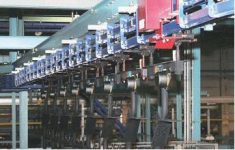
RFID was successfully applied in Ta’ao Auto Parts Company
[ad_1]
Application background
Since 2004, Ta’ao Automotive Parts Company’s factory has been moved to Ghent, Belgium, which is only 3 kilometers away from the Volvo factory. It mainly produces V50 parts and S40 models, and ships the products directly to Volvo factories. The molded parts are transported by train to Sweden and assembled in Ghent by welding to form the car base, roof, door, suspended parts in the car, and car cover. The annual output of the factory reaches 220,000 pieces. Luke Williams, maintenance engineer at Ta’ao, said: “We produce parts for about 700 vehicles every day and ship them to Volvo’s factory. Our factory has a minimum storage of parts that can be used for six hours of production; the maximum storage can be used for 18 hours of production.” Approximately 70 parts are transported by truck to the Volvo plant every day. In order to ensure the flexibility and punctuality required for delivery, the company must ensure the reliability of the production process. For this reason, production is mainly automated by more than 180 ABB manipulators.

In a highly automated factory like the Ghent factory of Ta’ao Automotive Parts Company, the internal conveyor chain greatly affects production efficiency. Transparent production, which is what we call “tracking and tracing”, plays a vital role here.The designers of Ta’ao Auto Parts Company installed for this designRFID. Although this is the first time this system has been adopted, the 0.5% error rate per round is still unsatisfactory, and other methods must be found. Luke Williams explained: “The biggest challenge in our production process is the ultra-high temperature, and many RFID systems are also troubled by this. The code carrier equipped with the parts must eventually be heated in an oven at 180°C. This creates a problem, what changes will happen to the circuit of the RFID carrier in such a high temperature environment?”
High temperature challenge
After some market research, Ta’ao’s decision makers found Turck’s BLiden-tRFID system, which can withstand temperatures from minus 40 degrees to minus 210 degrees. Williams said: “In addition to temperature resistance, another decisive factor in our choice of the BL identification system is that it can run the programmable controller independently, which is a function developed for industrial automation. The operating frequency of the BLident system is 13.56 Megahertz. It has the characteristics of high frequency and low noise according to international standards, which fully conforms to the overall concept of the system.”

With the first failure experience, TAAO conducted a comprehensive inspection of the BLident RFID system before using Turck’s products. Williams said: “As part of the test, we hung the code carrier in an oven at 180°C for ten days. Even after this level of rigid testing, the system can still operate normally.” Turck’s code carrier The body can be read and written directly after leaving the oven, but other systems must be cooled first. Turck has developed a special shell that is easy to assemble and disassemble for the heat-resistant code body. As long as it is used in accordance with the instructions, the guaranteed service life of Turck products is ten years. Today, Ta’ao has used a total of 240 high-temperature code carriers.
The BLident system is an open system that can be connected to all traditional fieldbuses. Turck provides interfaces for PROFIBUS DP, DeviceNet, Modbus TCP, Profinet and EtherNet/IP. Each interface has its own data storage to automatically adapt to different applications. Relying on the modular design, a BLident station can choose to use 2, 4, 6 or 8 channels. In addition, the RFID module can also be adjusted through software, and each channel has its own read-write head, which adopts parallel/multi-channel work respectively. This is especially important when the two read/write heads are very close, for example, the conveyor chain is divided into several sub-chains.
Improve efficiency
Williams added: “Many traditional RFID systems can only read and write statically, but BL recognition systems can read and write even when the identification tag is in motion (dynamic). This feature is very important to us.” Factory use The FRAM code carrier (ferromagnetic memory) enables faster data transmission and basically does not require any maintenance. The BL recognition system can process the read and write cycle at a maximum speed of 10m/s according to the different data volume transmitted by the code carrier. “By using the FRAM code carrier, we can reduce the reading and writing time at each station by about two seconds, so We can speed up the transmission chain-because there is no need to stop for reading and writing,” he continued, “naturally we can increase production.”

[ad_2]




